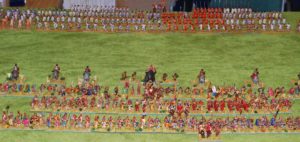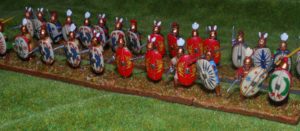The battle for next year’s SoA Battle Day is Kadesh, so I guess the time is coming to start doing some research on what forces we will need for the battle. And this seems to be one where there isn’t much information, so it will be mainly guesswork. Although that does mean it will be more difficult for someone to disagree.
So what do we think we know?
Firstly the course of the battle. This seems to have taken place in a number of phases.
Phase 1 is the attack of the Hittite chariotry from ambush into the marching Re division (Re may also have been crossing the river at the time). It ends with the effective destruction of Re as a coherent force and the Hittites pursuing the remnants north to the camp of the Amun division where Rameses was. It is possible that some of the Hittites may have pursued west and south as well (assuming that part of Re fled in that direction) and that they are not mentioned because they do not play any further part in the battle (or if they do they are not in the bit that reflects to Rameses’ glory and therefore are not mentioned).
Phase 2 is the Hittite pursuit into the camp of Amun. Initially there is confusion and slaughter of the Egyptians but Rameses single-handed rallies the Egyptians and puts the Hittites to flight. We can probably assume that there is an element of hyperbole in the accounts of Rameses’ role in this, but it is interesting that the Hittites are put to flight after a fight in a camp where you would expect their larger crews and close combat weapons to give them a decisive advantage over the Eygptians with their lighter chariots and bows. However the infantry will be on good ground in the camp – that they are not mentioned in the account might be because they are not Rameses. Rameses enumerates 2,500 chariots in the Hittite attack at this point – is that the number that led the attack in phase 1, or is that the remains after some turned south or west in pursuit (the 1,200 that would bring the 2,500 up to 3,700, but see phase 3 below)?. Even so, this is 2,500 against the 5,000 infantry and 500 chariots of Amun (plus any rallied remnants of Re).
Phase 3 is Muwatillis the Hittite king sending his reserves of 1,000 more chariots comprising the nobility across the river to support the fight in the camp. This would conveniently bring the original 2,500 up to nearly the total of 3,700 (which would then suggest that maybe only 200 chariots were lost by the Hittites in phase 1). At this point as they are about to join the fray, the mysterious Ne’arin appear from the north-west to reinforce Rameses. The Hittites turn and retreat or flee across the Orontes.
The second part is the numbers, which is important as we need to start sourcing figures:
Rameses states that the Hittite army was 37,000 infantry and 3,700 chariots, on a convenient 10:1 ratio. This seems to be repeated when contingents are mentioned as well.
The Egyptian army seems to have been in 4 divisions – Amun, Re, Ptah and Seth. Each division appears to have been 5,000 infantry (a total of 20,000 is mentioned). There is no total for the number of chariots, but as a working assumption it is possible that Rameses gets to his total of the number of Hittite infantry by taking the ratio of infantry to chariots of his own army and applying that to the chariot strength of the enemy army. As a working assumption therefore, lets assume that the Egyptians have 2,000 chariots, with 500 in each division.
In DBMM (for that is what we shall be using), each element is 250 infantry (or 1,000 if Hordes) or 50 chariots. That gives us rough numbers of elements for the two sides of:
Egyptians: 80 infantry + 40 chariots. Lets assume that each division is 10 Bd(F), 10 Bw(O) and 10 Cv(S). Plus we need more Caananite chariotry for the Ne’arin (if they are Caananites).
Hittites: 128 infantry (unless some are Hd) + 74 chariots. Actual troops are more difficult for the Hittites. As a working assumption again though we could guess that the chariots are 1/3 each Hittite, Anatolian vassal and Syrian vassal, so 25 Kn(O) and 50 Cv(O).
Thirdly, we need to construct a plausible narrative for the battle. This is difficult because the Egyptian account fairly obviously contains a lot of tosh. We need to create a new one which makes sense in the following ways:
1. The numbers need to be plausible (which they are – no million man armies here).
2. The tactics need to be plausible. Here we start getting sticky. Why did the Hittites not use any of their infantry to push their advantage? Was their scouting as bad as the Egyptians’, such that they didn’t know that there were 4 Egyptian divisions (plus the Ne’arin) and though that they had plenty of time to destroy Amun and Re. Or was the Hittite infantry of such poor quality that they didn’t dare risk it?
3. The outcome needs to be plausible. Obviously the rules won’t cover Rameses winning the battle single handed. We need to work out how and why the initial Hittite charge of 2,500 chariots managed to scatter 5,000 infantry and 500 chariots so easily. And we then need to work out what actually was happening in the camp.
And in addition, why does it then end? Why do both sides then pull off? Were the Hittites surprised by the size of the Egyptian army? Or had they lost too many nobles in the first day to want to continue. Rameses certainly seems to have effectively capitulated in order to extricate his army, so why did the Hittites not press home their advantage? Was it that the Hittite core of their army was actually quite small and they had had to over-commit it on the first day (which would imply that the rest of the army wasn’t really very good)? Were they worried that if the Hittite core took too much damage, this far from home, their local vassals would take an opportunity to finish off the King?





